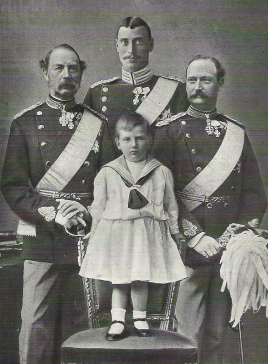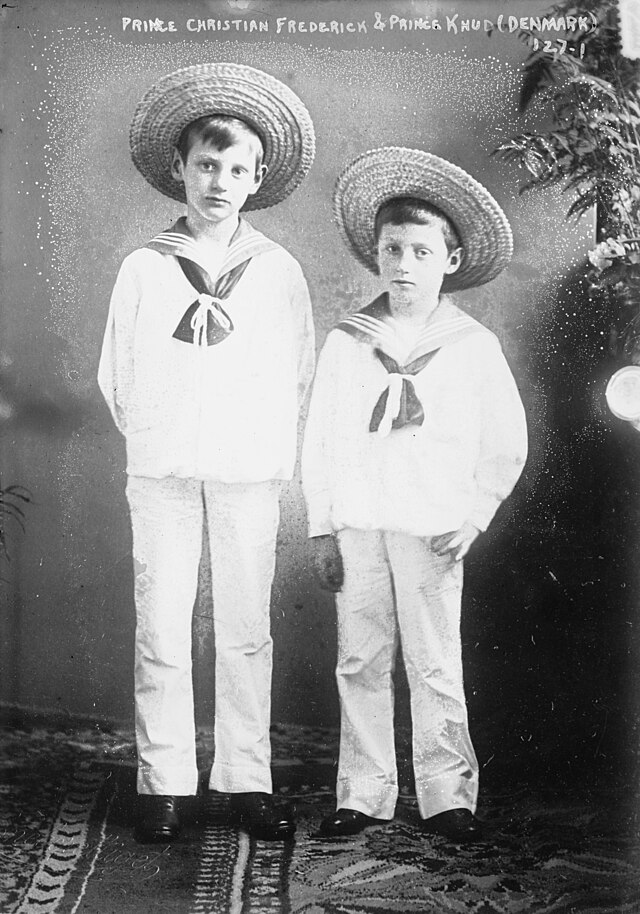by Susan Flantzer
© Unofficial Royalty 2015

King Frederik IX of Denmark; Credit – Wikipedia
King Frederik IX of Denmark was born on March 11, 1899, at Sorgenfri Palace in Kongens Lyngby, Denmark. He was the elder of the two sons of the future King Christian X of Denmark and his wife Alexandrine of Mecklenburg-Schwerin. With Frederik’s birth, there were four generations of Danish kings alive: the current monarch and Frederik’s great-grandfather King Christian IX, his grandfather the future King Frederik VIII, his father the future King Christian X, and baby Frederik.

Four generations of kings; Credit – Wikipedia
On April 9, 1899, the infant prince was christened Christian Frederik Franz Michael Carl Valdemar Georg. Frederik had an astounding 21 godparents including:
- King Christian IX of Denmark, paternal great-grandfather
- Nicholas II, Emperor of All Russia, his first cousin once removed
- King George I of Greece, his paternal grand uncle, born Prince Vilhelm of Denmark
- King Oscar II of Sweden and Norway
- Crown Prince Frederik of Denmark, later King Frederik VIII, his paternal grandfather
- The Prince of Wales, later King Edward VII of the United Kingdom, his great-uncle by marriage
- Friedrich Franz IV, Grand Duke of Mecklenburg-Schwerin, his maternal uncle
Frederik had one sibling:
- Prince Knud (1900 – 1976), married his first cousin Princess Caroline-Mathilde of Denmark, had one daughter and two sons

Frederik and his brother Knud; Credit – Wikipedia, United States Library of Congress Prints and Photographs Division
Frederik was educated at the Royal Danish Naval Academy and the University of Copenhagen. He had a career in the Royal Danish Navy where he had several senior commands and attained the rank of Rear Admiral. Frederik is famous for having acquired several tattoos during his time in the navy.

King Frederik IX showing off his physique and his tattoos; Photo Credit – http://cphpost.dk
In 1922, Frederik became engaged to his second cousin Princess Olga of Greece. However, the engagement was broken and Olga married Prince Paul of Yugoslavia. On March 15, 1935, Frederik became engaged to Princess Ingrid of Sweden, daughter of King Gustav VI Adolf of Sweden and his first wife Princess Margaret of Connaught, a granddaughter of Queen Victoria. The couple were married at the Storkyrkan in Stockholm, Sweden on May 24, 1935

Frederik and Ingrid ride through the streets after their wedding; Credit – Wikipedia
Frederik and Ingrid had three daughters:
- Queen Margrethe II of Denmark (born 1940), married Henri de Laborde de Monpezat, had two sons
- Princess Benedikte (born 1944), married Richard, 6th Prince of Sayn-Wittgenstein-Berleburg, had one son and two daughters
- Princess Anne-Marie (born 1946), married King Constantine II of Greece, had three sons and two daughters
Frederik and Ingrid’s firstborn child Margrethe was born within days of the German occupation of Denmark during World War II, and the little princess quickly became a bright spot in those terrible times. It was a common sight to see Frederik and Ingrid walking with Margrethe in her baby carriage through the streets of Copenhagen.
In 1947, Frederik succeeded to the throne upon the death of his father King Christian X. The Royal Ordinance of 1853 specified that the succession to the throne would be according to agnatic primogeniture, male succession, and the heir-presumptive to the throne was Hereditary Prince Knud, the King’s younger brother. Because of the unpopularity of Prince Knud and the belief that the 1853 succession law was outdated, the Danish Act of Succession was adopted on March 27, 1953. The new law allowed for female succession if the monarch had no sons. This enabled the daughters of King Frederik IX to supplant their uncle Knud in the line of succession. A 2009 succession law now allows for the succession of the firstborn child regardless of gender.
King Frederik and Queen Ingrid traveled on the royal yacht Dannebrog to most ports in Denmark and also to the Faroe Islands and Greenland. King Frederik IX had a warm, friendly personality and was able to break down the distance between the Danish people and the royal family. He once showed a TV reporter around Amalienborg Palace and said: “Yes, we live like other people. And here’s the tapestry hall.”

King Frederik and Queen Ingrid in 1950; Credit – Wikipedia; Photo: Sven Türck (1897-1954) Department of Maps, Print and Photographs, The Royal Library, Denmark
King Frederik also had a great love for music and was a talented pianist and conductor. Several recordings of orchestral music originally heard on Danish radio conducted by King Frederik have been released on CDs.
In January 1972, shortly after Frederik had given his New Year speech, he became ill with flu-like symptoms. On January 3, 1972, he had a cardiac arrest and was rushed to Copenhagen Municipal Hospital. He improved for a time but took a turn for the worse on January 11, and on January 14, 1972, King Frederik IX died at the age of 72. Unlike other Danish monarchs who had been buried inside Roskilde Cathedral, the burial place of Danish monarchs in Roskilde, Denmark, Frederik wanted to be buried outside in sight of the sea. He was succeeded by his eldest daughter, Queen Margrethe II. Queen Ingrid survived her husband by 28 years. When she died on November 7, 2000, her remains were interred alongside him outside Roskilde Cathedral.
Two photos of the burial site were taken by this writer who can verify that the Roskilde Fjord can be seen from the site of the grave.
This article is the intellectual property of Unofficial Royalty and is NOT TO BE COPIED, EDITED, OR POSTED IN ANY FORM ON ANOTHER WEBSITE under any circumstances. It is permissible to use a link that directs to Unofficial Royalty.
Kingdom of Denmark Resources at Unofficial Royalty
- Kingdom of Denmark Index
- Danish Orders and Honours
- Danish Royal Burial Sites: House of Oldenburg, 1448 – 1863
- Danish Royal Burial Sites: House of Schleswig-Holstein-Sonderburg-Glücksburg, 1863 – present
- Danish Royal Christenings
- Danish Royal Dates
- Danish Royal FAQs
- Danish Royal Residences
- Danish Royal Weddings
- Line of Succession to the Danish Throne
- Profiles of the Danish Royal Family



